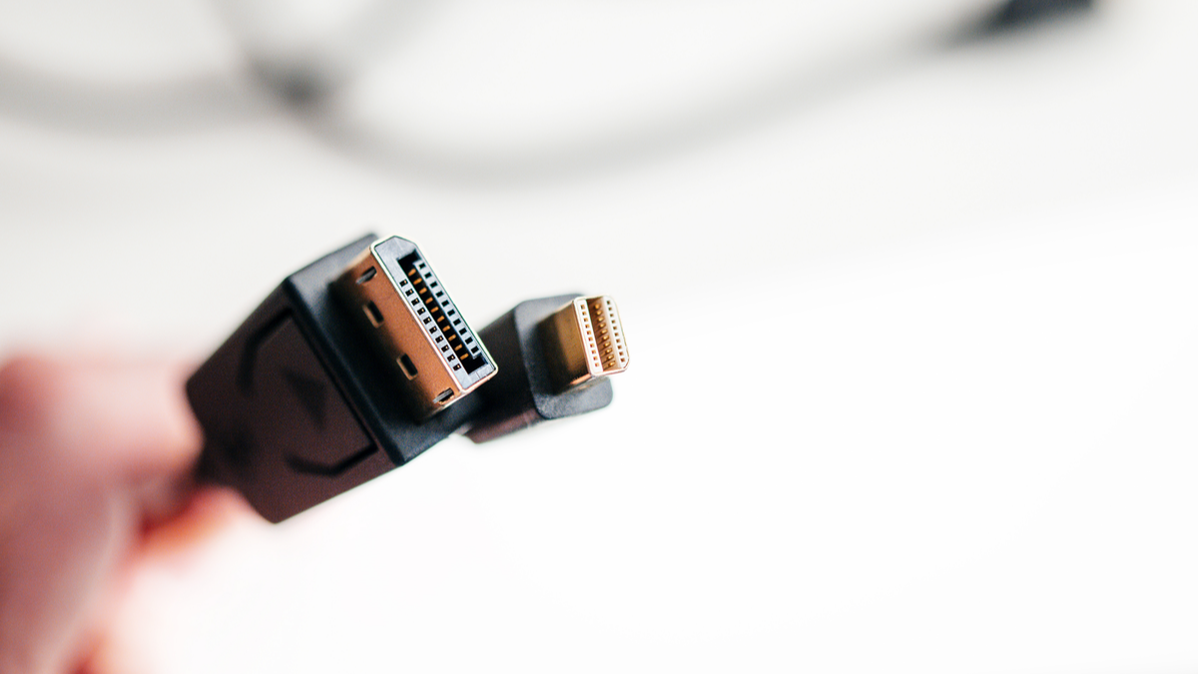
The Video Electronics Standards Association (VESA) announced the newest iteration of DisplayPort technology: DisplayPort 2. This new standard will support resolutions up to 16K and use either traditional DisplayPort connectors or USB-C. Expect to get your hands on it in 2022.
What Is DisplayPort?
DisplayPort is the video transfer standard that most people have never heard of. At a basic level, it’s nearly identical to HDMI. The current iteration of DisplayPort can transfer 8K video at 60 hertz and audio to TVs and monitors (HDMI 2.1 supports 10K). It comes in a large and mini form factor (like Mini HDMI). And, like HDMI cables, DisplayPort cables are really cheap.
So, why do people use DisplayPort at all? Well, for one, it’s useful for multiple monitor setups. Unlike HDMI, DisplayPort has a fancy “daisy chain” feature. You can plug one monitor into your computer via DisplayPort, and then run DisplayPort cables from that first monitor to the other screens in your setup. It’s clean, it’s intuitive, and computer professionals and PC gamers love it.
But unless you own a high-end monitor or computer, there’s a good chance that you can’t use DisplayPort at all. Since professionals and gamers usually use it, manufacturers don’t bother installing DisplayPorts in cheap computers, monitors, or TVs. So should you be interested in DisplayPort 2 at all? Is it groundbreaking in any way?
DisplayPort 2 Is Future-Proof and Ready for VR
The newest iteration of DisplayPort is, in essence, an upgrade to DisplayPort’s current specs. It’s pretty cut and dry. DisplayPort 2 supports 8K, 10K, and 16K video resolutions with a 60 Hz refresh rate (twice the resolution and bandwidth of current DisplayPort standards). It transfers data at a rate of 77.37 Gbps, and it will have HDR10 support. Plus, all DisplayPort 2 devices will require DSC support, which is a standard for lossless image compression that some manufacturers ignore.

These specs are impressive on their own. But they’re more impressive when you consider how they may influence virtual reality gaming. DisplayPort 2’s 77.37 Gbps payload delivery is more than ideal for VR gaming, and VESA claims that the upgraded video standard can send 4K 60 Hz video to up to two VR headsets at a time (via the daisy-chaining feature, which is quite naturally a part of DisplayPort 2.)
And, thankfully, DisplayPort 2 is backward compatible with older DisplayPort hardware (the cable shape hasn’t changed). This shouldn’t be an issue for small devices like phones and laptops — USB-C is also fully compatible with DisplayPort 2 (more on that in a second.)
With 16K video and VR-friendly data transfer speeds, DisplayPort 2 looks to be future-proof. It’s possible that we won’t see an upgrade to the video standard for another decade.
DisplayPort 2 Piggy-Backs on USB-C
If you’ve never bought a DisplayPort cable, you may never buy a DisplayPort 2 cable. This isn’t a knock at the format — it’s actually a sign that VESA knows how to ensure the survival of DisplayPort. While DisplayPort 1 required the DisplayPort connector, DisplayPort 2 can also work over USB-C.
You read that right. VESA is embracing the standard USB-C connector.

Advertisement
USB-C is set to replace the DisplayPort and HDMI ports on almost all consumer-grade electronics (it’s already the standard on MacBooks). This is possible because USB-C cables support what are called alt modes. This is a little confusing, but every USB-C cable contains four data transfer lanes, and each lane has a bandwidth of 20 Gbps. In alt mode, the direction of these lanes can be altered, so a computer can send data at a rate of 80 Gbps to, say, a monitor.
Sound familiar? The 77.37 Gbps data transfer rate of DisplayPort 2 can fit comfortably in a USB-C alt mode. This doesn’t mean that you’ll need an adapter to connect a USB-C cable to a TV or monitor. It means that your next DisplayPort 2 compatible TV or monitor will have USB-C ports, and you’ll be able to transfer video from any phone or computer to that display via USB-C.
When Will Devices Have DisplayPort 2?
VESA planned for DisplayPort 2 to hit the consumer market in late 2020, but that release has repeatedly been pushed back. Currently, DisplayPort 2 is expected to make an appearance in mid-2022. But really, this transition is all up to computer, phone, TV, and display manufacturers. If a device isn’t built to support DisplayPort 2, then that’s that. A USB-C port along won’t cut it, the internals of the device must be upgraded to the newest DisplayPort standard.
That being said, it’s likely that DisplayPort 2 will come to high-end devices and displays before it comes to $200 laptops and discounted TVs. HDMI 2.1 is capable of handling 10K video, so there isn’t much incentive for manufacturers to immediately abandon the technology for cheap products.
Sources: VESA
